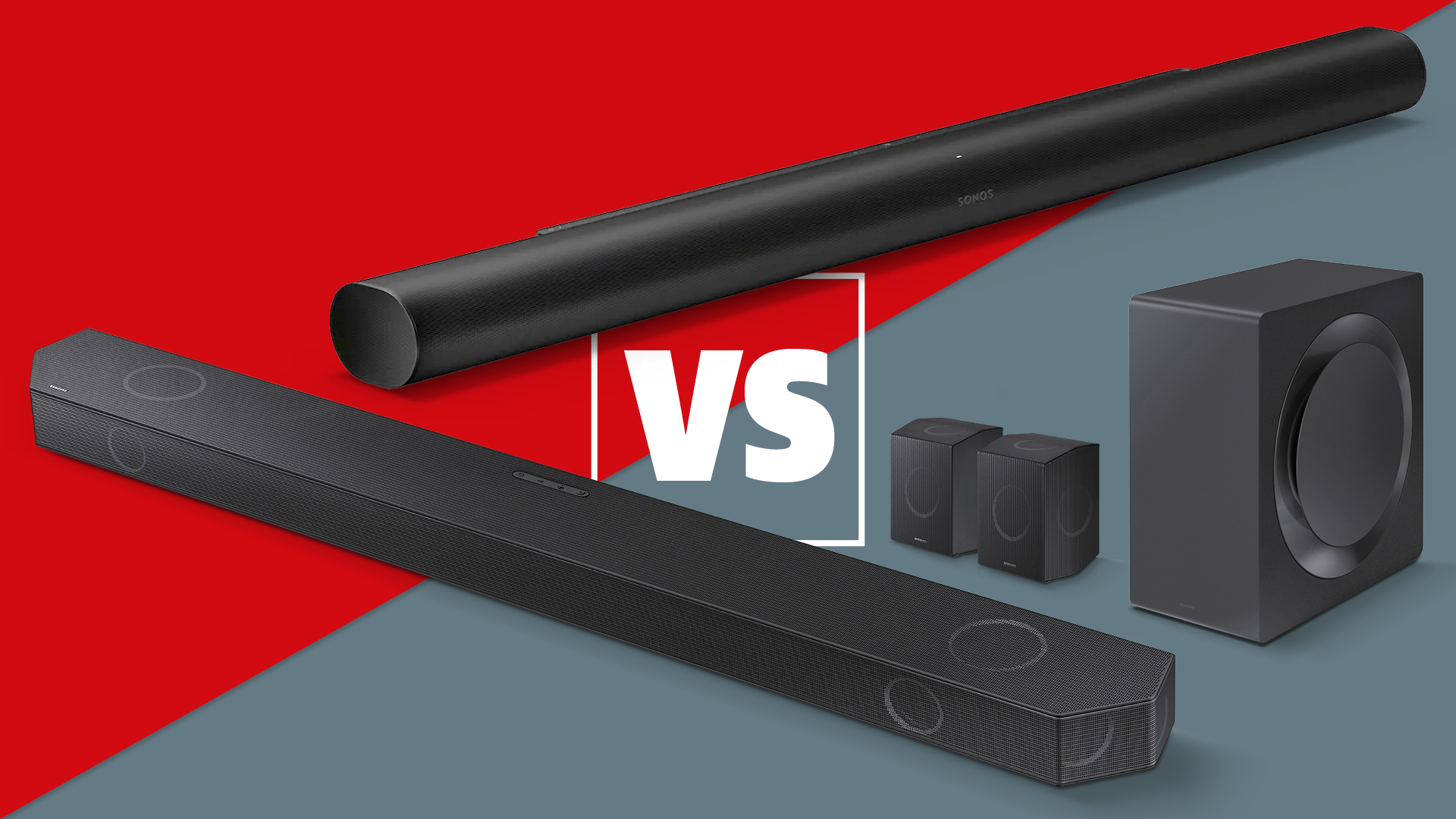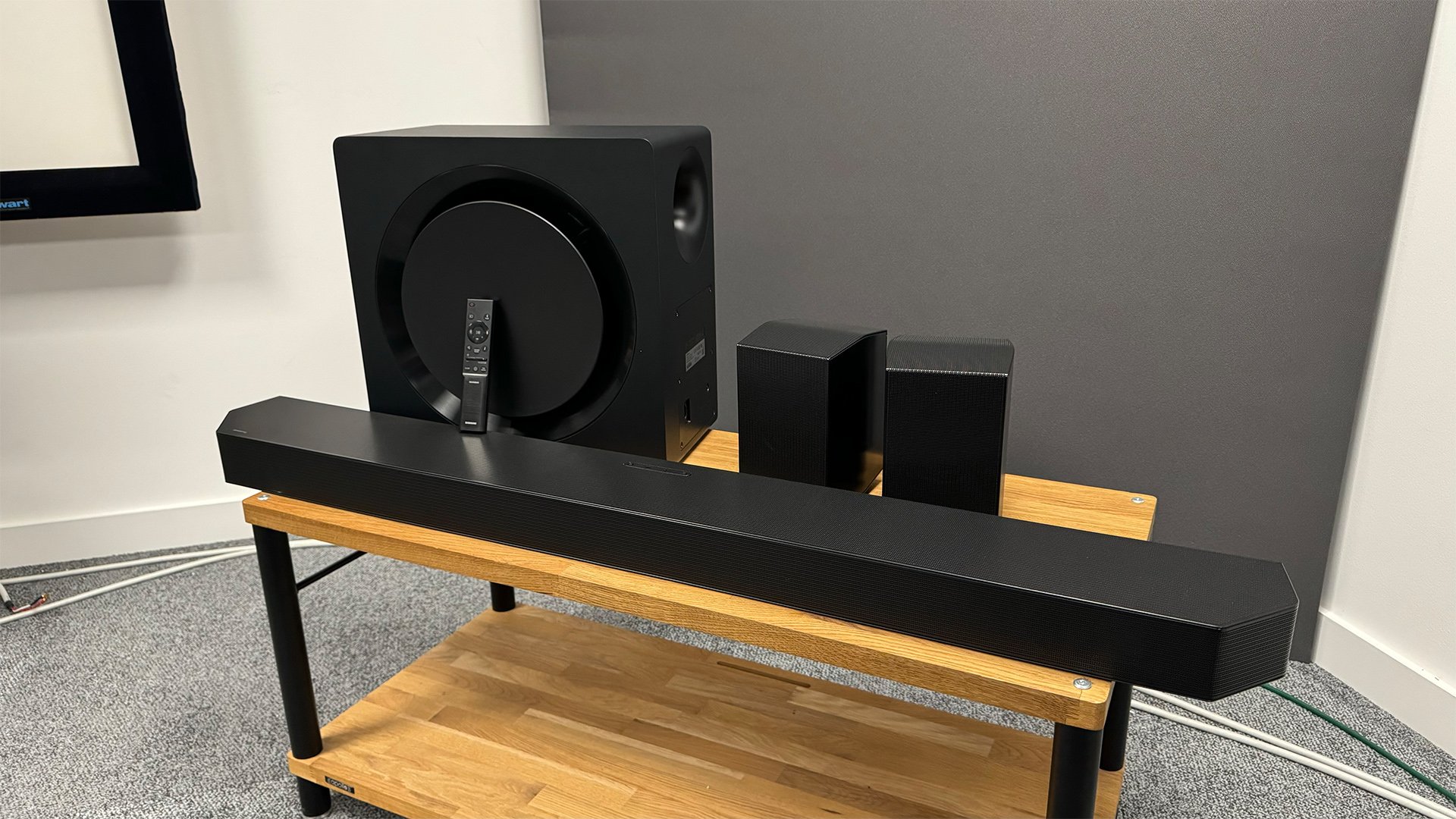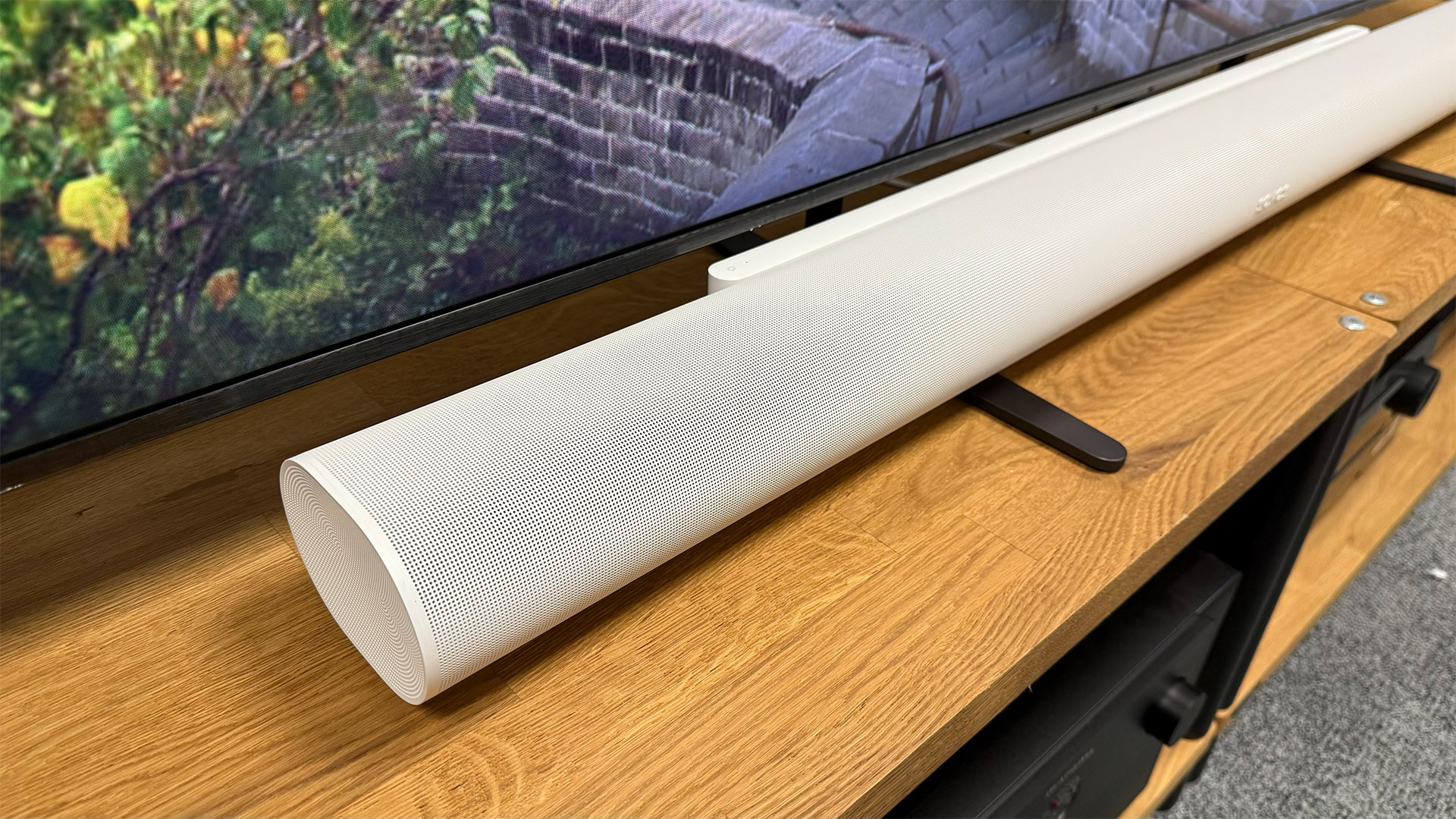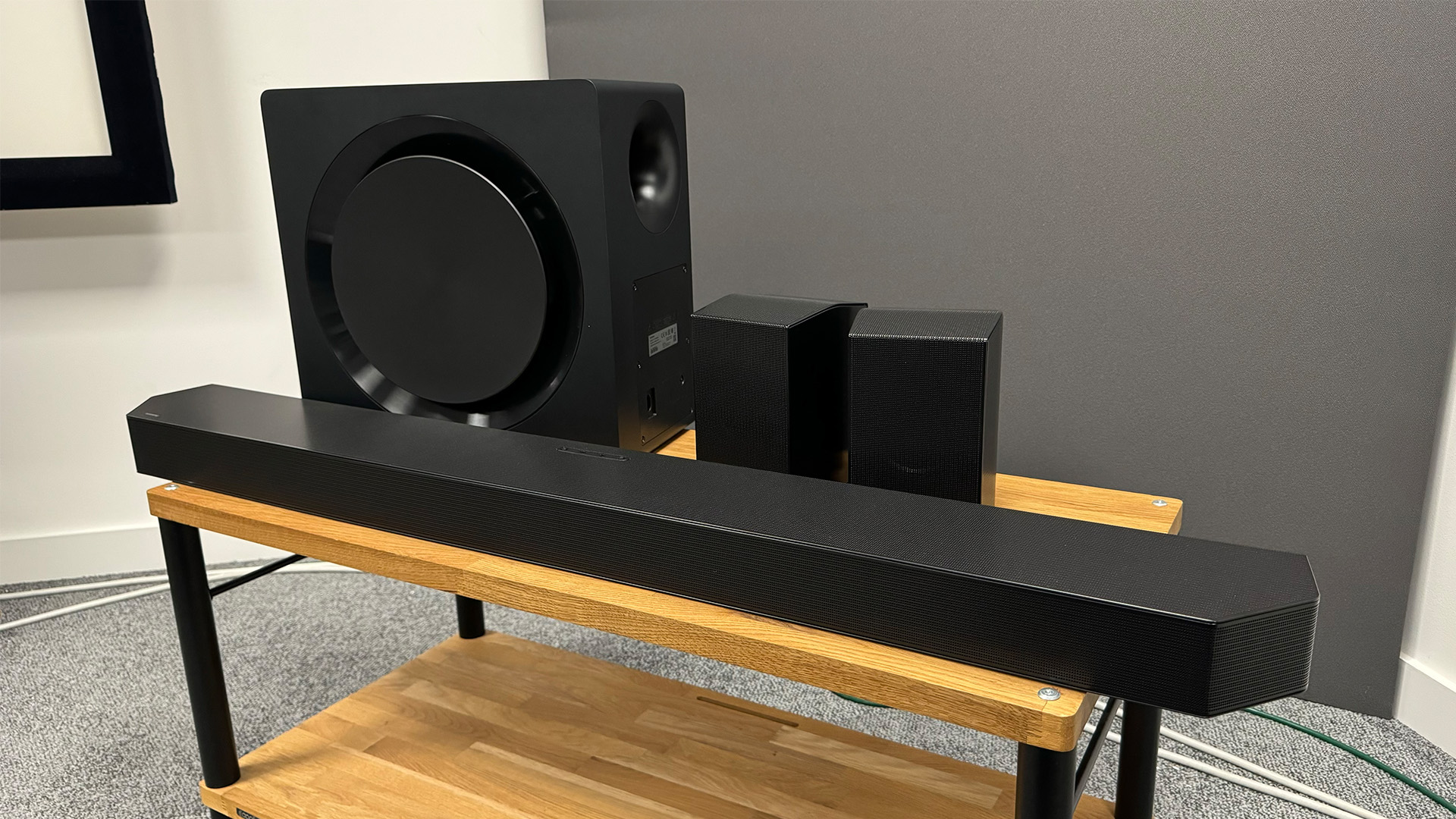
Connections: HDMI, optical, ethernet
ARC/eARC: eARC
Bluetooth: Yes
Dimensions (hwd): 7.5 x 118 x 11 cm
Weight: 5.9kg
With more drivers, new Sound Motion technology for improved bass, and extra features like Bluetooth and advanced Speech Enhancement, the Arc Ultra is Sonos' premium home cinema option. Musically, it's a little better than the Samsung, but it can't fill a room quite as well.
For
- Clean, precise, spacious and three-dimensional sound
- Deep, tuneful and expressive bass
- Terrifically detailed for a soundbar
Against
- No HDMI passthrough
- No DTS support
- Still some app issues
Connections: HDMI out (eARC), 2 x HDMI 2.1 in, optical
ARC/eARC: eARC
Bluetooth: Yes
Dimensions (hwd): 6.9 x 123 x 14 cm (soundbar only)
Weight: 7.7kg (soundbar only)
Thanks to its separate subwoofer and satellite speakers, the Q990D is closer to a full surround system, and so it tends to fill the room with sound better than the Arc Ultra. But it does suffer the occasional bout of distortion, and musically, it's not as adept as the Arc Ultra. Though it does win in terms of connection ports.
For
- Large, immersive and three-dimensional sound
- Dynamic, weighty and detailed
- Two HDMI 2.1 inputs
Against
- Very occasional bassy crackle
- Hard-to-read display
There's a new version of the Sonos Arc soundbar. The Sonos Arc Ultra promises 'breakthrough' sound technology and up to double the bass of the original Arc. If you are familiar with the five-star, multi-Award-winning Arc, you will know that those are bold claims indeed.
But of course other soundbars are available besides those made by Sonos. The Arc Ultra will have to compete with the Samsung HW-Q990D, winner of our Best Soundbar System in the 2024 What Hi-Fi? Awards. Can the new Arc cut it against such stiff competition? Let's see...
Sonos Arc Ultra vs Samsung HW-Q990D: price

The Sonos Arc Ultra is a premium proposition, but it is still significantly cheaper than the Samsung HW-Q990D. That's because the latter is a soundbar system, comprising a soundbar, wireless subwoofer and two wireless surround speakers.
The Arc Ultra costs £999 / $999 / AU$1799. That's fairly cheap compared with the HW-Q990D, which officially costs £1699 / $2000 / AU$2099.
But that's only half the story. The HW-Q990D has been discounted heavily – in recent weeks, it has dropped to the same £999 as the Ultra. Being a brand new Sonos flagship, the Arc Ultra isn't likely to see any hefty discounts soon, even come Black Friday. If the Samsung gets a great deal, it could even be the cheaper of the two.
** Winner: Draw **
Sonos Arc Ultra vs Samsung HW-Q990D: design

Visually, the Arc Ultra is very similar to the original Arc, but there are some differences.
The Ultra has a 'ledge' at the back of the top of the chassis, which houses the touch controls (on the original, they were built into the main grille). The Ultra is a little wider and slightly less tall, so less likely to obstruct any of your TV screen. It is also a little lighter.
It has the same grille design as the original, with sound firing out in all directions. Just don't put anything above it, as that will hamper its upward-firing drivers.
The Q990D also looks very similar to its predecessor, the Q990C. It's a little more serious and – dare we say, boring – than the Ultra, but it is a very functional design, able to blend into most decors.
It's wider than the Ultra (123cm to 118 cm), and a little less tall (6.9cm to 7.5cm). That means it might be harder to fit on a TV cabinet, but is even less likely to obscure the bottom part of your TV's screen. The Q990D's isolating feet are positioned about 20cm from each end, but there are also isolation pads so you can place it on the bottom plate of a TV pedestal stand. It comes with brackets for wall-mounting the soundbar, but not the satellite speakers.
Its HDMI ports are a little awkward to access (though you shouldn't have to do that very often), and the display has room for only three characters at a time, which means waiting for it to scroll. But many rivals, including the Sonos Arc Ultra, have no display at all.
** Winner: Sonos Arc Ultra **
Sonos Arc Ultra vs Samsung HW-Q990D: features

The Arc Ultra again packs Dolby Atmos (but not DTS:X) and has more drivers than the original Arc. Like its predecessor, it lacks any dedicated HDMI ports of its own – it connects to your TV via eARC, and you route any external sources through the TV. That could be a problem for gamers with more than one modern console or gaming PC whose TV only has two HDMI 2.1 ports – with the Arc Ultra taking up one, that leaves only one 2.1-compatible port free for a games machine, so you will have to do some port switching to change consoles. It's a bit of a first-world problem, but could be annoying if you switch gaming platforms a lot.
This is the first Arc with Bluetooth, and you can now perform Trueplay calibration from an Android device as well as iOS.
It can be controlled via the Sonos app and your voice (as well as your TV's remote and the touch controls on the 'bar itself). The app also includes EQ controls and features such as Night mode (which reduces dynamics and bass so that the sound travels less readily between rooms), and Speech Enhancement (which now has different levels so that you can control to what degree the dialogue is projected).
The Ultra plays nicely with other Sonos devices including the Era 300 and Sub 4 as part of a full surround system, and the Sonos Ace headphones for personal viewing – you can instantly switch sound output from the Ultra to the Ace, with spatial audio and dynamic head tracking making it seem like you're not wearing headphones at all.
The Samsung HW-Q990D is an absolute beast – an 11.1.4-channel system with a total of 22 drivers. In the 'bar itself, there are six elliptical midrange drivers, three forwards-firing tweeters, four side-firing drivers and two up-firers. The two surround speakers each contain one forward-, one side- and one up-firing driver, and the subwoofer has a 20cm driver behind its plastic plate.
One of its key features is SpaceFit calibration. Using the soundbar's mic, this automatically analyses the room and speaker placement and optimises the sound to give you the best experience. It's a doddle to use, and runs constantly whenever SpaceFit is selected – you won't have to wave your phone around the room to get it working.
There are four presets (Standard, Surround, Game Pro and Adaptive Sound). While Standard outputs in the number of channels in the source signal (2.0, 5.1, 7.1 or 7.1.4, and so will never use the Q990D's full complement of channels), the other modes do upmix to 11.1.4. Unlike the Arc Ultra, the Q990D supports DTS:X as well as Dolby Atmos.
It has other modes, too – Active Voice Amplifier, Voice Enhancement, Bass Enhancement, Night Mode and Virtual – which are basically ways of enhancing or subduing one part of the soundfield. The subwoofer also has a dedicated bass volume control, and you can adjust the volume of individual speakers using the remote (though not using the app, which would make more sense).
The Q990D features two HDMI ports, both of which are certified 2.1. That means they support gaming features such as 4K/120Hz, VRR and ALLM, which is a boon to any gamers whose TV has only two 2.1 ports. Also to its credit, the Q990D supports Dolby Vision (which Samsung's TVs do not) as well as the HLG, HDR10 and HDR10+ formats of HDR.
It is well served wirelessly, with Chromecast, Spotify Connect and Bluetooth on board. You can even connect it to a Samsung TV wirelessly should you wish, though we would always use an HDMI cable for a more robust connection.
Pair it with a Samsung TV, and you will be able to control the soundbar's settings from the TV screen. It also enables the Q-Symphony mode, which uses the TV's speakers as part of the sound setup as an enlarged centre channel.
** Winner: Samsung HW-Q990D **
Sonos Arc Ultra vs Samsung HW-Q990D: sound

Key to the Sonos Arc Ultra's sound performance are its new Sound Motion drivers.
Instead of having one heavy motor, these have four smaller lightweight motors that can push the cone to shift more air and produce more bass.
Sound Motion features only in the woofer – otherwise, its 9.1.4-channel configuration comprises 15 Class D amplifiers powering 14 drivers, including seven tweeters, six midrange woofers and the woofer. The original Arc had only a 5.0.2 arrangement, so this is a really big step up.
And so it proves. Playing music, the Ultra steps up the performance in terms of precision, crispness and tightness, and there's much more bass. The low end doesn't just have more weight, but more composure too, which is one of the most impressive elements of the Ultra.
This bass really comes into its own when playing movies, and adds to the atmosphere no end. By comparison, the original Arc sounds a little wooly and overbearing.
For a soundbar, the Ultra is able to place sounds around the room with an impressive level of accuracy and detail. Dialogue projects further and is clearer too.
But the Samsung HW-Q990D is an Award winner, and deservedly so. Its SpaceFit calibration works a treat, bringing the surrounds into play more, to make for a more striking and atmospheric experience. But if you find them too distracting, turning off SpaceFit makes the sound more subtle but no less engaging.
In terms of sound modes, we prefer Surround to Adaptive, but only just. Adaptive is a bit more forthright, but it also exaggerates certain effects occasionally. Surround is a little softer but still lively with plenty of bass and punch.
Its Dolby Atmos effects are excellent, filling the room with sound and placing effects in mid-air with precision. The height definitely adds to the experience, but it's the sense of depth that really impresses.
But it's not flawless. There is the occasional crackle of distortion from the sub and rear speakers, but only in extreme circumstances, and it's quickly brought under control. There is also none of the sustained chuffing with which many products suffer.
The Q990D is impressively dynamic and handles big shifts in volume with aplomb. It’s pretty good at low-level dynamics, too. Dialogue is always clear, even during busy scenes, and it picks out fine details amid the chaos very well.
With music, it does a very good job of spreading a stereo feed across the system's 11.1.4 channels. "Played in this way, music sounds full-bodied, dynamic and clear, and some will enjoy hearing their favourite tracks converted to a fairly Atmos-like presentation," we said in our review. Switch to stereo in Standard mode, and there is decent clarity, energy and tonal balance, but it's not quite as musical as the Sonos Arc Ultra.
Finally, Q-Symphony does as it promises, widening the soundstage and enhancing the dialogue to be more easily comprehended.
Thanks to its satellite speakers, the Q990D does a better job of filling the room with sound. If you want to use the Ultra with extra Sonos Era 300 speakers and/or a Sub 4, you're going to face a much higher bill, but it does create a compelling setup. We'll bring you a full review of this arrangement soon.
** Winner: Draw **
Sonos Arc Ultra vs Samsung HW-Q990D: verdict
A tricky one, this. Both have lots of factors acting in their favour.
The Ultra is the better looker, and syncs seamlessly with other Sonos devices. But then The Q990D has an abundance of wireless technologies, not to mention two HDMI 2.1 sockets. The Ultra makes the Award-winning Arc sound a little tame, but can't fill a room to the same extent as the HW-Q990D.
The Arc Ultra is cheaper, but then the HW-Q990D has been reduced to the same price lately, and could even fall further.
If you own other Sonos products, the Arc Ultra will be another mighty fine purchase that will slot right into your system. But if it's a one-and-done home cinema setup you're after, the Samsung HW-Q990D will serve you well.
MORE:
Sonos Arc Ultra vs Sonos Arc: which Dolby Atmos soundbar is better?
Looking to test your soundbar or system? These are the best Dolby Atmos test scenes
Check out the best Dolby Atmos soundbars







